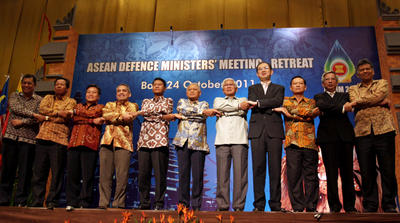The Association of Southeast Asian Nations (ASEAN) clearly plays a unique and leading role in building a strong economic and financial architecture in Asia, as all major regional and interregional forums gravitate around it. Moving towards its goal of creating an ASEAN Economic Community by 2015, ASEAN has forged a series of free trade agreements (FTAs) — called ASEAN+1 FTAs — with its dialogue partners, while non-ASEAN members have also implemented various FTAs. As a result, the number of FTAs in Asia has surged over the last 10 years, creating an Asian ‘noodle bowl’ situation.
To tackle the Asian noodle bowl, numerous proposals have been made to consolidate overlapping FTAs into a single regional FTA, like an East Asia Free Trade Area (EAFTA) among the ASEAN+3 countries — the 10 ASEAN members plus the People’s Republic of China (PRC), Japan and the Republic of Korea — or a Comprehensive Economic Partnership in East Asia (CEPEA) among the ASEAN+6 countries — also including Australia, India and New Zealand. These initiatives may be seen as a first step towards the creation of a region-wide economic community. A large region-wide FTA would also stimulate the growth of regional demand and the rest of the world’s exports, thereby contributing to the reduction of global economic imbalances.
The realisation of a single regional FTA in Asia would require both a trilateral FTA among the PRC, Japan and Korea and its integration with the existing ASEAN+1 FTAs. The biggest challenge lies in summoning the political will of these countries not only to liberalise trade in goods and services and investment, but also to reduce behind-the-border barriers, harmonise rules, regulations and standards, and pursue further domestic reforms. Deeper trade and investment integration at the regional level would serve the interests of firms and consumers, regionally as well as globally, and be highly complementary with World Trade Organization (WTO) liberalisation which does not require deep integration.
Does the Trans-Pacific Partnership (TPP) agreement, which is considered an early step toward a larger APEC-wide FTA, impede Asia-wide trade integration? The answer is no. While some Asian countries might decide to join the TPP for security and geopolitical reasons as it strengthens ties with the United States, the TPP would make any Asian member a more open economy. Institutional competition created by the TPP process would force some countries, notably the PRC, to accelerate the process of forging an Asia-wide FTA. In fact, the PRC and Japan are together now more aggressive in promoting an EAFTA/CEPEA. In this sense, the two processes are not mutually exclusive and can be complementary and create synergy.
On the financial front, the ASEAN+3 countries have strengthened regional financial and monetary cooperation following the Asian financial crisis. Important recent progress includes the multilateralisation of the Chiang Mai Initiative (CMIM), the establishment of the ASEAN+3 Macroeconomic Research Office (AMRO) in Singapore, and the creation of the Credit Guarantee and Investment Facility (CGIF) as an ADB-based trust fund in Manila under the Asian Bond Markets Initiative.
The CMIM needs improvements if it is to become a full-fledged regional facility and promote regional financial stability. First, at US$120 billion it is too small and needs to be substantially expanded. Second, a new precautionary credit facility should be introduced to prevent a crisis from developing, because the current arrangement is designed to address crises only after they occur. Third, the CMIM should be delinked from International Monetary Fund (IMF) programs. Fourth, the AMRO needs to acquire sufficient resources and staffing to support its surveillance capabilities and to facilitate policy dialogues among the finance ministers and central bank governors. Once these shortcomings are addressed, the CMIM and AMRO can be transformed into a de facto Asian monetary fund, and the principles governing their cooperation with the IMF in providing liquidity assistance can be determined.
Regional financial stability requires further institutional support. For example, Asian financial authorities — including finance ministries, central banks, and financial supervisory and regulatory agencies — could choose to establish an ‘Asian financial stability dialogue’ to complement efforts by the Financial Stability Board at the global level. Such a dialogue would bring together all the financial authorities in the region to discuss regional financial market vulnerabilities, regional financial and capital flows, common issues affecting financial sector supervision and regulation, and efforts to strengthen regional financial integration.
Asia’s regional institutions can complement and work with global institutions in a number of functional areas. In the area of development finance, regional development banks already exist alongside the World Bank, and the challenge is to improve the division of labour between regional and global development banks. In other areas where global institutions exist but regional institutions do not, there is substantial scope for creating new regional institutions — to promote trade and investment expansion, and economic and financial stability as international public goods — and for redesigning the prospective division of labour between global and new regional institutions, based on the principle of subsidiary.
The development of effective regional institutions in Asia in support of global governance can be hugely beneficial, not only for Asia, but also for the global community as a whole. It would result in Asia acting more responsibly, with greater accountability in its management of regional and global issues, and the provision of international public goods. It can also give Asia a bigger voice and result in a more effective Asian input in the global governance system. Regional institution-building should not be considered an end in itself and should further the shared goals of all countries, both within and outside the region.
Masahiro Kawai is Dean of the Asian Development Bank Institute (ADBI) and previously served as a Special Advisor to the ADB President responsible for regional economic cooperation and integration. Before joining ADBI he was Professor of Economics at the University of Tokyo.
This article appeared in the most recent edition of the East Asia Forum Quarterly, ‘Asia’s global impact‘.

